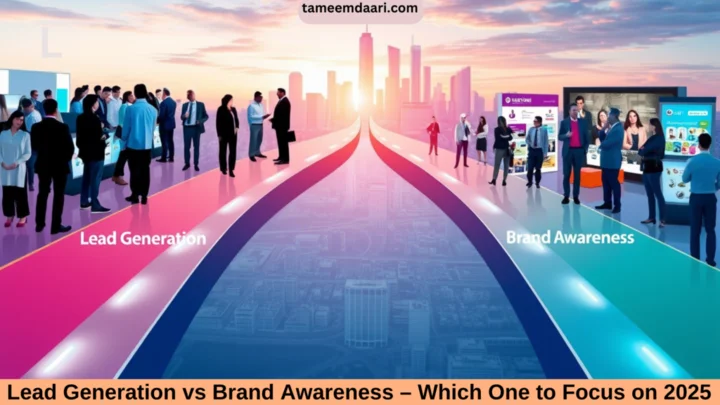The digital marketing landscape is evolving faster than ever, and businesses face a critical question as 2025 approaches: Should they prioritize lead generation or brand awareness? Both strategies are essential for growth, but limited budgets and shifting consumer behaviors force companies to choose where to allocate resources.
In this comprehensive Lead Generation vs Brand Awareness – Which One to Focus on 2025 guide, we’ll dissect the differences between lead generation and brand awareness, analyze emerging trends, and provide data-backed recommendations to help you dominate your niche in 2025.
Understanding the Core Concepts
What is Lead Generation?
Lead generation is the process of attracting and converting prospects into potential customers (leads) through targeted tactics. The primary goal is to drive immediate sales opportunities by capturing contact information—such as emails and phone numbers—via forms, landing pages, or chatbots.
Key Strategies for Lead Generation
- Pay-Per-Click (PPC) Ads: Platforms like Google Ads and LinkedIn Ads.
- Gated Content: eBooks, webinars, and whitepapers.
- Email Marketing Campaigns
- SEO-Optimized Landing Pages
- Retargeting Ads
Essential Metrics to Track
- Conversion Rates
- Cost Per Lead (CPL)
- Lead Quality
- Sales Pipeline Velocity
What is Brand Awareness?
Brand awareness focuses on making your brand recognizable and memorable to a broad audience. This long-term strategy builds trust, credibility, and emotional connections with consumers, even if they aren’t ready to purchase immediately.
Key Strategies for Building Brand Awareness
- Social Media Campaigns: Utilize platforms like TikTok and Instagram Reels.
- Influencer Partnerships
- Content Marketing: Blogs, podcasts, and videos.
- Sponsorships and Event Marketing
- Viral Campaigns and Storytelling
Essential Metrics to Track
- Social Media Reach and Impressions
- Organic/Search Website Traffic
- Brand Sentiment (via surveys and reviews)
- Share of Voice Compared to Competitors
Lead Generation vs. Brand Awareness: Key Differences
Comparative Overview
| Factor | Lead Generation | Brand Awareness |
|---|---|---|
| Primary Goal | Immediate conversions | Long-term recognition |
| Audience Targeting | Narrow (high intent) | Broad (untapped audiences) |
| ROI Timeline | Short-term (weeks/months) | Long-term (6+ months) |
| Budget Allocation | Higher cost per acquisition | Lower cost per impression |
| Content Focus | Transactional | Emotional/Educational |
2025 Trends Shaping the Battle
AI and Automation
- For Lead Generation:
AI tools like ChatGPT enhance lead scoring and personalize outreach. - For Brand Awareness:
AI-driven content creation streamlines storytelling across multiple platforms.
Privacy Regulations
- Impact:
With the phase-out of third-party cookies and stricter GDPR laws, contextual targeting will rise. Brands must pivot to using first-party data for lead gen and organic reach for awareness.
Video Dominance
- For Brand Awareness:
Short-form video content (TikTok, YouTube Shorts) will be key. - For Lead Generation:
Live shopping and demo videos drive immediate engagement and conversions.
Economic Uncertainty
- Focus Shift:
Inflation and recession fears may force businesses to lean towards lead generation for quick revenue, though investing in brand awareness during downturns can yield long-term competitive advantages.
When to Prioritize Each Strategy in 2025
When to Prioritize Lead Generation
- Startups and SMBs:
Require immediate revenue to sustain operations. - B2B Companies:
High-ticket sales necessitate nurturing qualified leads. - Limited Budgets:
Focus on low-CPL channels like email and SEO. - Product Launches:
Create urgency with limited-time offers.
When to Prioritize Brand Awareness
- Established Brands:
Essential for maintaining market leadership and customer loyalty. - Entering New Markets:
Introduce your brand to unfamiliar audiences. - Highly Competitive Industries:
Differentiate through storytelling and brand values. - Long Sales Cycles:
Build trust and credibility before driving conversions.
The Hybrid Approach: Balancing Both Strategies
A combined strategy can often yield the best results:
Integrating Lead Generation and Brand Awareness
- Cross-Channel Campaigns:
Use brand awareness initiatives to nurture cold audiences, then retarget with lead generation ads. - Content Repurposing:
Transform gated content from lead gen into snackable social media posts to boost brand recognition. - Account-Based Marketing (ABM):
Blend personalized outreach with brand credibility to capture high-value targets.
Conclusion
Deciding between lead generation and brand awareness in 2025 depends on your business goals, industry, and resources. Choose lead generation if you need immediate revenue, operate in a niche B2B space, or have a limited budget. Opt for brand awareness if you’re scaling into new markets, competing in saturated industries, or building a legacy brand.
Ultimately, the future belongs to marketers who skillfully blend both approaches. A recommended allocation is to dedicate 60-70% of your budget to the strategy that aligns with your primary goals for 2025, while using the remaining 30-40% to support complementary initiatives.
